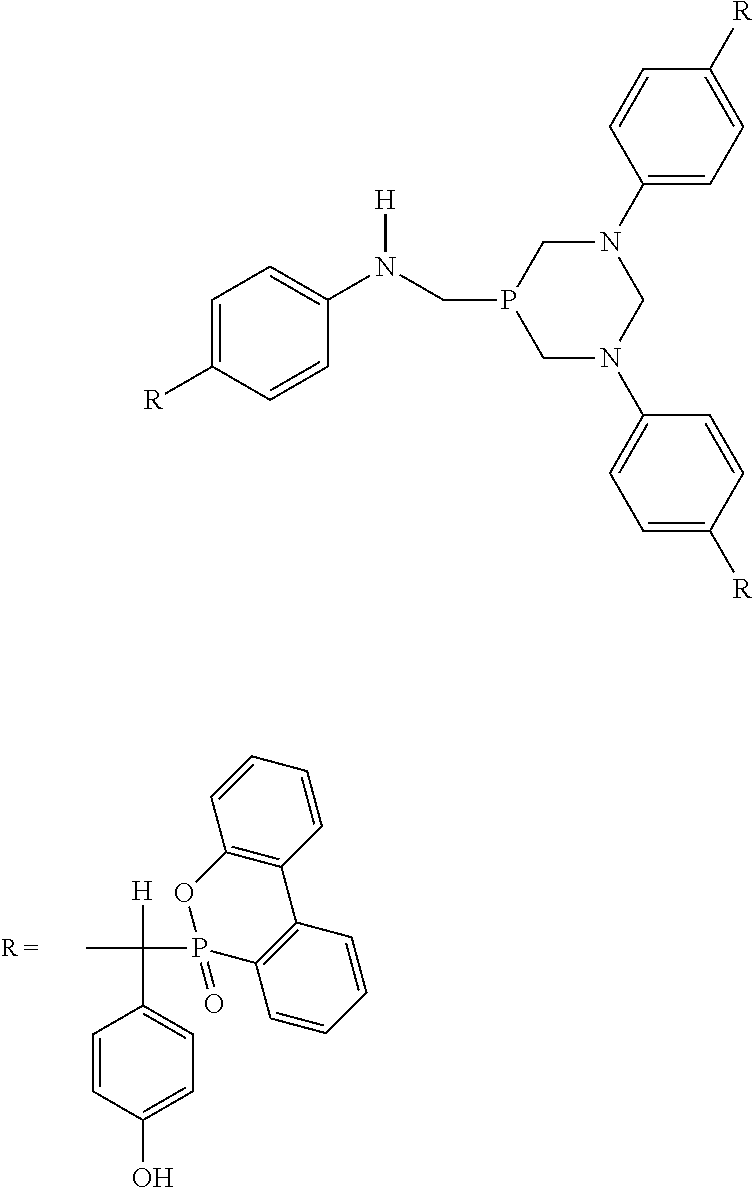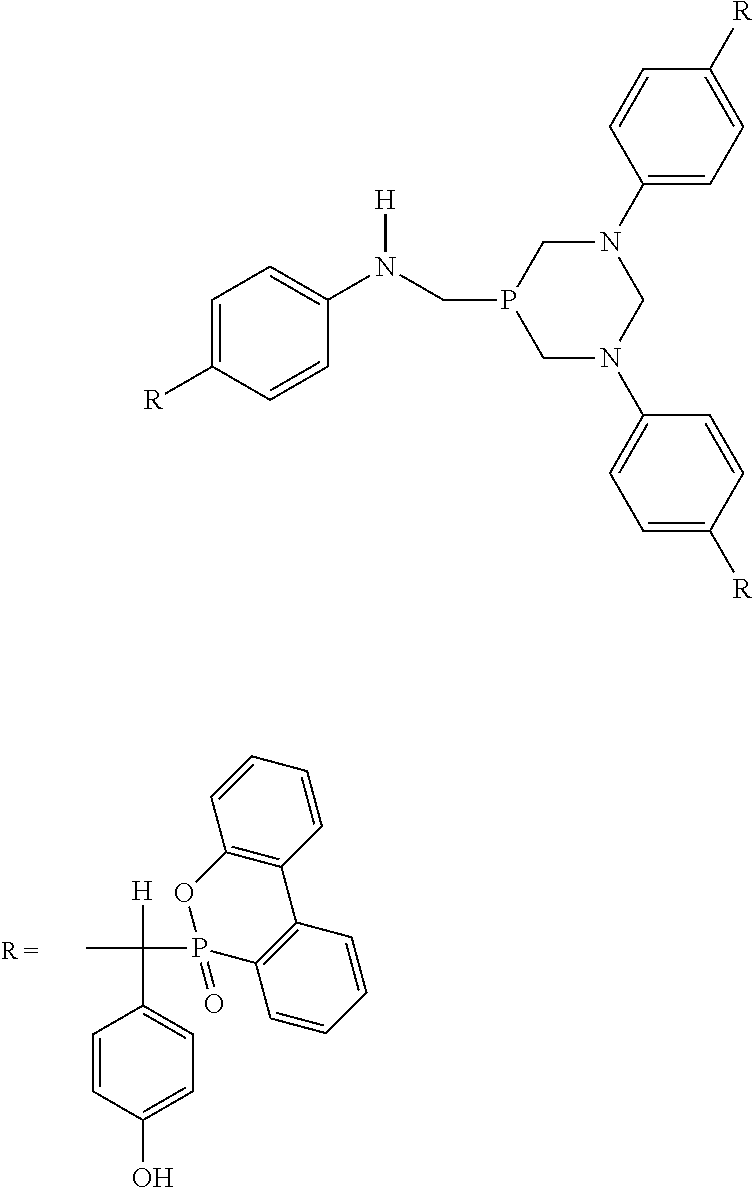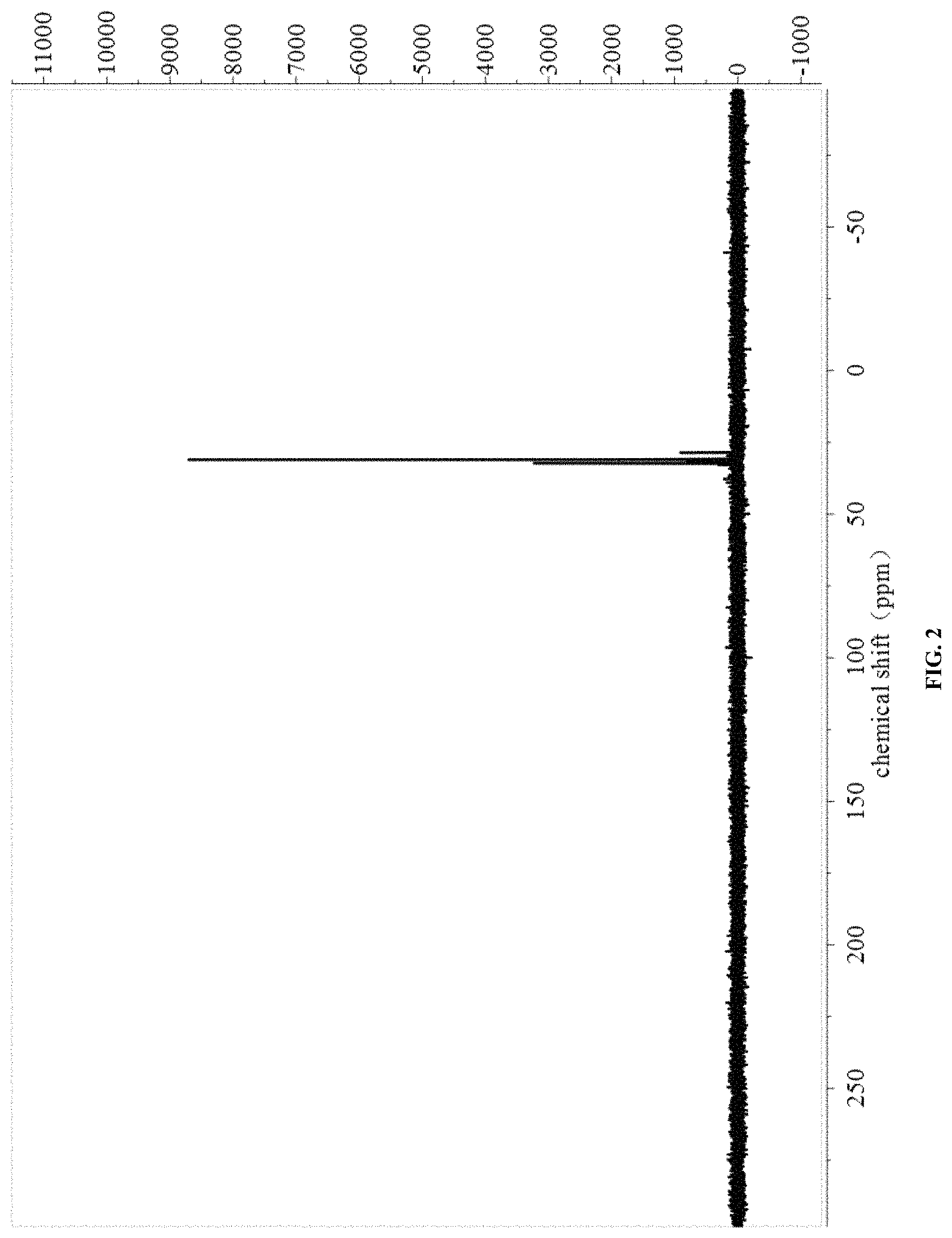Preparation method of phosphaphenanthrene-structure reactive flame retardant and application thereof
Dai , et al.
U.S. patent number 10,618,923 [Application Number 16/463,735] was granted by the patent office on 2020-04-14 for preparation method of phosphaphenanthrene-structure reactive flame retardant and application thereof. This patent grant is currently assigned to XIAMEN UNIVERSITY. The grantee listed for this patent is XIAMEN UNIVERSITY. Invention is credited to Guorong Cehn, Lizong Dai, Kaibin He, Jiamei Huang, Chao Liu, Xinyu Liu, Wei'ang Luo, Yiting Xu, Cohghui Yuan, Birong Zeng.





| United States Patent | 10,618,923 |
| Dai , et al. | April 14, 2020 |
Preparation method of phosphaphenanthrene-structure reactive flame retardant and application thereof
Abstract
Disclosed are a phosphaphenanthrene-structure reactive flame retardant and an application thereof. The preparation method comprises: enabling 9,10-dihydro-9-oxa-10-phosphaphenanthrene-10-oxide (DOPO), p-hydroxy benzaldehyde (4-HBA), and 5-aminomethyl-1,3-diphenyl-1,3,5-diphosphonitryl heterocycles to react under a certain condition to obtain the reactive flame retardant with a benzene ring rigid structure containing polyhydroxy. Compared with an ordinary flame retardant, the phosphaphenanthrene-structure reactive flame retardant has the characteristics that polyfunctionality is achieved, the molecular structure is stable, the hydrolysis resistance is better, and less migration in epoxy resin, moreover, the flame retardant property of the epoxy resin can be remarkably improved.
| Inventors: | Dai; Lizong (Xiamen, CN), Liu; Chao (Xiamen, CN), Cehn; Guorong (Xiamen, CN), Huang; Jiamei (Xiamen, CN), Xu; Yiting (Xiamen, CN), Zeng; Birong (Xiamen, CN), Luo; Wei'ang (Xiamen, CN), Yuan; Cohghui (Xiamen, CN), He; Kaibin (Xiamen, CN), Liu; Xinyu (Xiamen, CN) | ||||||||||
|---|---|---|---|---|---|---|---|---|---|---|---|
| Applicant: |
|
||||||||||
| Assignee: | XIAMEN UNIVERSITY (Xiamen,
Fujian, CN) |
||||||||||
| Family ID: | 58444415 | ||||||||||
| Appl. No.: | 16/463,735 | ||||||||||
| Filed: | November 23, 2017 | ||||||||||
| PCT Filed: | November 23, 2017 | ||||||||||
| PCT No.: | PCT/CN2017/112584 | ||||||||||
| 371(c)(1),(2),(4) Date: | May 23, 2019 | ||||||||||
| PCT Pub. No.: | WO2018/095362 | ||||||||||
| PCT Pub. Date: | May 31, 2018 |
Prior Publication Data
| Document Identifier | Publication Date | |
|---|---|---|
| US 20190382427 A1 | Dec 19, 2019 | |
Foreign Application Priority Data
| Nov 23, 2016 [CN] | 2016 1 1036541 | |||
| Current U.S. Class: | 1/1 |
| Current CPC Class: | C08K 5/0066 (20130101); C08G 59/5033 (20130101); C08G 59/623 (20130101); C07F 9/6584 (20130101); C08K 5/0066 (20130101); C08L 63/00 (20130101) |
| Current International Class: | C07F 9/6584 (20060101); C08G 59/62 (20060101) |
References Cited [Referenced By]
U.S. Patent Documents
| 3897205 | July 1975 | Frank et al. |
| 102134304 | Jul 2011 | CN | |||
| 102219806 | Oct 2011 | CN | |||
| 104231309 | Dec 2014 | CN | |||
| 104558684 | Apr 2015 | CN | |||
| 104844745 | Aug 2015 | CN | |||
| 106554483 | Apr 2017 | CN | |||
Other References
|
Arlen, W. Frank et al. Aniline Derivatives of Tetrakis (Hydromethyl) Phosphonium Chloride. The Journal of Organic Chemistry. Dec. 31, 1972, pp. 2752-2755, vol. 37-17, 4 pages. cited by applicant. |
Primary Examiner: Parsa; Jafar F
Attorney, Agent or Firm: Muncy, Geissler, Olds & Lowe, P.C.
Claims
The invention claimed is:
1. A preparation method of the phosphaphenanthrene-structure reactive flame retardant, ##STR00003## comprising the steps: under the protection of nitrogen, the reactant 5-aminomethyl-1,3-diphenyl-1,3,5-diphosphonitryl heterocycle, 4-hydroxybenzaldehyde, DOPO and solvent are sequentially added to a vessel, and then p-toluene sulfonic acid is added as a catalyst, the mixture is heated and reacted for a period of time, a pale yellow solution is obtained, the solvent is removed by concentration, and the crude product is separated by column chromatography to obtain the phosphaphenanthrene-structure reactive flame retardant; wherein, the molar ratio of the 5-aminomethyl-1,3-diphenyl-1,3,5-diphosphonitryl heterocycle, 4-hydroxybenzaldehyde, DOPO is 1:2-6:3-7; the amount of the catalyst p-toluene sulfonic acid is 1%-10% of the mass fraction of the 5-aminomethyl-1,3-diphenyl-1,3,5-diazophosphorus heterocycle; the solvent is toluene, the reaction temperature is 100-180.degree. C., and the reaction time is 8-20 h.
2. The preparation method of the phosphaphenanthrene-structure reactive flame retardant according to claim 1, wherein the molar ratio of the 5-aminomethyl-1,3-diphenyl-1,3,5-diphosphonitryl heterocycle, 4-hydroxybenzaldehyde, and DOPO is 1: 3-5: 4-6.
3. The preparation method of the phosphaphenanthrene-structure reactive flame retardant according to claim 1, wherein the amount of the catalyst p-toluene sulfonic acid is 2%-8% of the mass fraction of the 5-aminomethyl-1,3-diphenyl-1,3,5-diazophosphorus heterocycle.
4. The preparation method of the phosphaphenanthrene-structure reactive flame retardant according to claim 3, wherein the solvent is toluene, the reaction temperature is 120-160.degree. C., and the reaction time is 10-16 h.
5. The preparation method of the phosphaphenanthrene-structure reactive flame retardant according to claim 1, wherein the column chromatography is performed by using 300-400 mesh silica gel as the stationary phase, ethyl acetate: petroleum ether volume ratio =4:1 as the mobile phase, and 5 ml of glacial acetic acid is added to every 100 mL of the eluent.
6. A preparation method of flame retardant polymer material, comprising the following steps: epoxy resin prepolymer is heated to a certain temperature, stirred, a certain mass fraction of the phosphaphenanthrene-structure reactive flame retardant according to claim 1 is added, stirred until the mixture is uniformily transparent, then, a curing agent is added by stoichiometric ratio, poured into an aluminum mould after the curing agent is completely dissolved, then a curing procedure is set to cure the mixture, and the flame retardant epoxy resin is obtained.
7. The preparation method of flame retardant polymer material according to claim 6, wherein epoxy resin prepolymer is heated to 85-100.degree. C., stirred for 20-40 min; the mass fraction of the phosphaphenanthrene-structure reactive flame retardant added is 1-30%, and continue to be stirred for 40-80 min; the curing procedure is at 120-130.degree. C. for 4 h, continue to be kept at 130-150.degree. C. for 2 h, and finally kept at 150-170.degree. C. for 2 h.
Description
TECHNICAL FIELD
The invention relates to a flame retardant, in particular to a preparation method of phosphaphenanthrene-structure reactive flame retardant and application thereof.
BACKGROUND ART
Since Castan and Greenlee invented epoxy resin at the same time in 1936, epoxy resin has been widely used in almost all aspects of social life, such as transportation, infrastructure construction, ships and oceans, astronautics and electrical engineering, because of its good physical and chemical properties. Nevertheless, due to the flammability of common epoxy resin, it cannot meet the requirements of use in many fields. With the development of the epoxy resin industry in the direction of refinement, it has become a research hotspot to develop new and high-efficiency flame retardants to improve the flame retardancy of epoxy resins.
At present, with species diversity in epoxy resin flame retardant, practice of classification is also different. According to the elements contained in flame retardant, it can be classified into phosphorus, nitrogen, silicon, fluorine or synergistic flame retardant containing two or more elements. The retardant can be further subdivided into an additive type and a reactive type based on whether or not it has a functional group capable of reacting with epoxy resin. The reactive flame retardant has a long-lasting flame retardant effect, does not migrate in the epoxy resin, and can maintain or improve its mechanical properties while improving the flame retardancy of the epoxy resin.
Gao et al. (Gao L P, Wang D Y, Wang Y Z, et al. Polymer Degradation and Stability, 2008, 93(7): 1308-1315.) synthesized a kind of phosphorus-containing monomer DODPP with a single reactive functional group, and then DODPP in different proportions reacted with DGEBA, obtaining the epoxy resin with different phosphorus content. When the phosphorus content was 2.5%, the cured product could reach UL-94 V-0 rating and 30.2% limiting oxygen index (LOI). The values of HRR, PHRR and Av-HRR obtained by heat release test all decreased. Murias (Murias P, Maciejewski H, Galina H. European Polymer Journal, 2012, 48(4): 769-773.) synthesized two kinds of siloxanes with a terminal amino group or an epoxy group, with triethylenetetramine as curing agent and co-cured with a low molecular weight epoxy (E6) to obtain an epoxy cured product. When the amount of siloxane added was increased, the LOI value of the obtained epoxy cured product was also increased from 21.9% up to 23.9%, and the impact strength was significantly improved.
SUMMARY OF THE INVENTION
The invention relates to a phosphaphenanthrene-structure reactive flame retardant and application thereof.
The phosphaphenanthrene-structure reactive flame retardant is prepared by the reaction of bis[tetrakis(hydroxymethyl)phosphonium] sulfate (THPS), aniline, glacial acetic acid, p-hydroxybenzaldehyde (4-HBA) and 9,10-dihydro-9-oxa-10-phosphaphenanthrene-10-oxide (DOPO).
The phosphaphenanthrene-structure reactive flame retardant structure is as follows:
##STR00001##
The synthesis route of the phosphaphenanthrene-structure reactive flame retardant is as follows:
##STR00002##
The synthesis steps of the phosphaphenanthrene-structure reactive flame retardant are as follows:
(1) the method for synthesizing 5-aminomethyl-1,3-diphenyl-1,3,5-diphosphonitryl heterocycle (hereinafter referred to as substance I) is according to Frank A Drake Jr G L. The Journal of Organic Chemistry, 1972, 37(17): 2752-2755;
(2) DOPO, 4-HBA and substance I are added to a three-necked bottle, a catalytic amount of p-toluene sulfonic acid is added, protected with nitrogen, heated up and magnetically stirred, and react for a certain period of time;
(3) column chromatography with silica gel as stationary phase is used for separation after the reaction is completed.
Wherein the molar ratio of the substance I, 4-hydroxybenzaldehyde and DOPO is 1:2-6:3-7;
the use amount of the catalyst p-toluene sulfonic acid is 1%-10% of the mass fraction of substance I;
the solvent is toluene, the reaction temperature is 100-180.degree. C., the reaction time is 8-20 h.
The preparation method for the reactive flames retardant with multifunctional groups, is composed of the following steps:
1. the molar ratio of DOPO, 4-HBA and substance I in step (2) can be 4: 3: 1-6: 5: 1, the use amount of the catalyst p-toluene sulfonic acid is 2%-8% of the mass fraction of substance I; the reaction temperature is from 120.degree. C. to 160.degree. C., and the reaction time is from 10 to 16 hours;
2. the eluent for the column chromatography in the step (3) is ethyl acetate:petroleum ether=4:1 (volume ratio), and 5 mL of glacial acetic acid is added to per 100 mL of the eluent.
The flame retardant of the present invention has the following advantages:
(1) The molecular structure of the flame retardant contains three hydroxyl groups, which can react with the epoxy group and participate in the curing of the epoxy resin. Compared with the common reactive flame retardant, it has more functional groups and exhibits more firmly bond to the matrix after modifying the epoxy resin
(2) The molecular structure of the flame retardant has a plurality of benzene rings and dense rings, and the phosphorus, carbon and nitrogen atoms form a six-membered heterocycle. Therefore, it has higher thermal stability and hydrolysis resistance.
(3) The relative molecular weight of the flame retardant is 1321. Compared to small molecule flame retardants, it can be better present in epoxy resins without migration.
DRAWINGS
FIG. 1 shows the nuclear magnetic hydrogen spectrum of the flame retardant in embodiment 1.
FIG. 2 shows the nuclear magnetic phosphorus spectrum of the flame retardant in embodiment 1.
DETAILED DESCRIPTION
The present invention is further described below by means specific embodiments.
Embodiment 1
2.16 g (0.01 mol) of DOPO, 0.732 g (0.006 mol) of 4-HBA, 0.722 g (0.002 mol) of substance I were added in a three-neck flask respectively, 0.0864 g (the mass fraction relative to substance I is 4%) of p-toluene sulphonic acid was added, protected by nitrogen, heated to 130.degree. C., and magnetically stirred for 12 h. After completion of the reaction, silica gel was used as stationary phase, ethyl acetate:petroleum ether=4:1 as eluent, 5 mL of glacial acetic acid was added to every 100 mL of the eluent, and the product was separated by column chromatography.
The NMR spectra were shown in FIG. 1 and FIG. 2.
Embodiment 2
2.592 g (0.012 mol) of DOPO, 0.732 g (0.006 mol) of 4-HBA, 0.722 g (0.002 mol) of substance I were added in a three-neck flask respectively, 0.0864 g (the mass fraction relative to substance I is 4%) of p-toluene sulphonic acid was added, protected by nitrogen, heated to 130.degree. C., and magnetically stirred for 16 h.
After completion of the reaction, silica gel was used as stationary phase, ethyl acetate:petroleum ether=4:1 as eluent, 5 mL of glacial acetic acid was added to every 100 mL of the eluent, and the product was separated by column chromatography.
Embodiment 3
2.592 g (0.012 mol) of DOPO, 0.976 g (0.008 mol) of 4-HBA, 0.722 g (0.002 mol) of substance I were added in a three-neck flask respectively, 0.0864 g (the mass fraction relative to substance I is 4%) of p-toluene sulphonic acid was added, protected by nitrogen, heated to 130.degree. C., and magnetically stirred for 16 h. After completion of the reaction, silica gel was used as stationary phase, ethyl acetate:petroleum ether=4:1 as eluent, 5 ml of glacial acetic acid was added to every 100 mL of the eluent, and the product was separated by column chromatography.
Embodiment 4
2.592 g (0.012 mol) of DOPO, 0.732 g (0.006 mol) of 4-HBA, 0.722 g (0.002 mol) of substance I were added in a three-neck flask respectively, 0.0864 g (the mass fraction relative to substance I is 4%) of p-toluene sulphonic acid was added, protected by nitrogen, heated to 130.degree. C., and magnetically stirred for 16 h. After completion of the reaction, silica gel was used as stationary phase, ethyl acetate:petroleum ether=4:1 as eluent, 5 mL of glacial acetic acid was added to every 100 mL of the eluent, and the product was separated by column chromatography.
The preparation of the pure epoxy resin and modified epoxy resin with the flame retardant, and the procedures of the fire retardant tests were as follows:
(1) Preparation of Pure Epoxy Resin
20 g of epoxy resin E-51 was taken, heated to 100.degree. C., 4 g of curing agent 4,4'-diaminodiphenylmethane was added, stirred well, poured into a mould, heated at 120.degree. C. for 4 h, then kept at 140.degree. C. for 2 h, and finally kept at 160.degree. C. for 2 h.
(2) Preparation of Reactive Flame Retardant-Modified Epoxy Resin
20 g of epoxy resin E-51 was taken, heated up to 100.degree. C., 2.13 g of the flame retardant (the mass of the phosphorus element was 1% of the mass of the epoxy resin, the following addition amount of flame retardant was based on the mass of phosphorus element), after stirred and dissolved, the small molecular substance were removed under vacuum, 4 g of curing agent 4,4'-diaminodiphenylmethane was added, stirred well, poured into the mould, kept at 120.degree. C. for 4 h, then kept at 140.degree. C. for 2 h, finally, kept it at 160.degree. C. for 2 h, and the reactive flame retardant-modified epoxy resin was obtained. According to this method, modified epoxy resin was prepared by adding 6.39 g and 10.66 g of the flame retardant (corresponding phosphorus content was 3% and 5% respectively) to 20 g of epoxy resin respectively.
(3) The limiting oxygen index of the obtained sample was tested according to the method of GB/T 2406.2-2009.
The results of the limiting oxygen index test were shown in Table 1.
TABLE-US-00001 TABLE 1 The results of the limiting oxygen index for the epoxy resins modified with different content of phosphorus Phosphorus Control content group 1% 3% 5% Oxygen index 26.3 32.2 36.2 38.4 (LOI)
As mentioned above, these are only preferred embodiments of the present invention, so the scope of implementation of the present invention cannot be limited accordingly. That is, the equivalent changes and modifications made according to the patent scope and description content of the present invention should still be within the scope of the present invention.
* * * * *
uspto.report is an independent third-party trademark research tool that is not affiliated, endorsed, or sponsored by the United States Patent and Trademark Office (USPTO) or any other governmental organization. The information provided by uspto.report is based on publicly available data at the time of writing and is intended for informational purposes only.
While we strive to provide accurate and up-to-date information, we do not guarantee the accuracy, completeness, reliability, or suitability of the information displayed on this site. The use of this site is at your own risk. Any reliance you place on such information is therefore strictly at your own risk.
All official trademark data, including owner information, should be verified by visiting the official USPTO website at www.uspto.gov. This site is not intended to replace professional legal advice and should not be used as a substitute for consulting with a legal professional who is knowledgeable about trademark law.